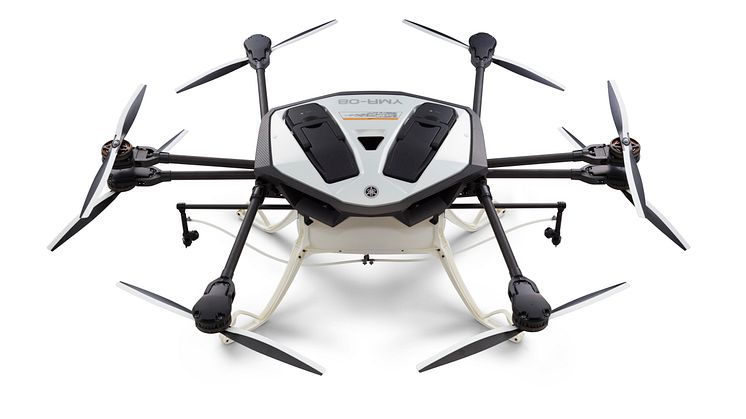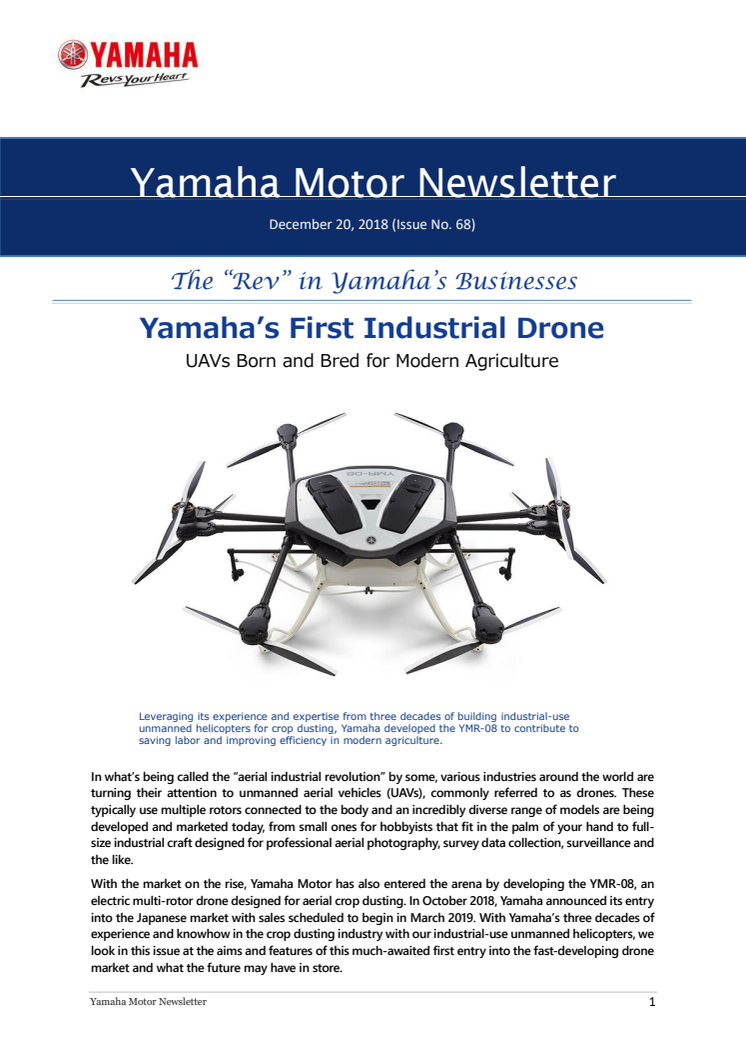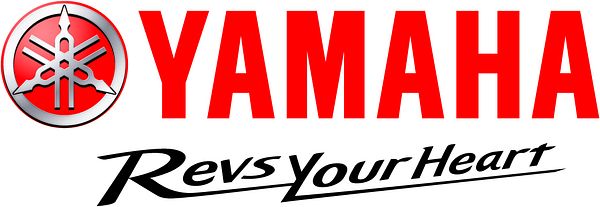
News -
Yamaha’s First Industrial Drone Yamaha Motor Newsletter (December 20, 2018 No. 68)
In what’s being called the “aerial industrial revolution” by some, various industries around the world are turning their attention to unmanned aerial vehicles (UAVs), commonly referred to as drones. These typically use multiple rotors connected to the body and an incredibly diverse range of models are being developed and marketed today, from small ones for hobbyists that fit in the palm of your hand to full-size industrial craft designed for professional aerial photography, survey data collection, surveillance and the like.
With the market on the rise, Yamaha Motor has also entered the arena by developing the YMR-08, an electric multi-rotor drone designed for aerial crop dusting. In October 2018, Yamaha announced its entry into the Japanese market with sales scheduled to begin in March 2019. With Yamaha’s three decades of experience and knowhow in the crop dusting industry with our industrial-use unmanned helicopters, we look in this issue at the aims and features of this much-awaited first entry into the fast-developing drone market and what the future may have in store.
Origins: Aerial Agriculture
At Yamaha Motor’s Unmanned System (UMS) Section, the core products are our lineup of industrial-use unmanned helicopters. Yamaha was the first in the world to succeed in commercializing remote-controlled unmanned helicopters in 1987. Even back then, addressing the aging and shrinking of Japan’s agricultural workforce was a pressing social issue. As pest control with rice paddies is particularly hard work, Yamaha was commissioned to develop a remote-controlled machine that could perform the job from the air and thereby contribute to reducing workload and boosting efficiency.
The principal advantages of using unmanned helicopters for crop dusting are that it is far less strenuous than carrying a pump with an agrichemical tank strapped to the back or operating a land vehicle to spray crops. And then there’s the tremendous savings in time; it takes about 2 hr. 40 min. to spray 1 hectare on foot versus just 10 min. with an unmanned helicopter. Also, compared to crop dusting with manned aircraft, there is far less spray drift onto neighboring lands and a much more even spray. For these reasons, some 2,700 Yamaha unmanned helicopters are currently in use in Japanese agriculture (as of Dec. 2017), spraying over one million hectares each year. With rice paddies, their main field of operation, our helicopters cover more than 40% of the area under cultivation.
However, the problems Japanese agriculture faces are only growing more severe. Between 1995 and 2015, the agricultural workforce shrank to almost half and the average age of workers rose by seven years to 66. In response, Yamaha looked to take labor-saving and efficiency a level higher and turned its focus to places its unmanned helicopters weren’t ideal for, like smaller fields in mountainous areas or near residential areas. There were also calls for an aerial spray solution that was simpler, easy to use and affordable enough for individual farmers to purchase, so Yamaha Motor rose to meet these user needs and developed the YMR-08 multi-rotor drone.
Our gas-powered FAZER R unmanned helicopter can carry up to 32 liters of agrichemicals and spray 4 hectares in one flight, but these are usually owned by agricultural unions or specialized crop-dusting operators for spraying large-scale farming areas across each region.
In contrast, with the small farms dotting mountainous areas and those near residential areas, there has been a rapidly growing demand for quiet, compact electric multi-rotor drones that can be easily used whenever needed by individual farmers. There are already more than 1,300 such drones registered for agriculture use in Japan and total demand for 2018 is expected to reach 700 units.
As our unmanned helicopters work best with large-scale farmland, Yamaha decided to respond to this new trend by pioneering a market and creating new demand by building a product that could do the same work as our helicopters on a smaller scale, and set to work on developing the YMR-08. It was designed with the spraying performance, user features, quality and reliability to differentiate it from the competition, but also to make it a trustworthy solution for individual farmers as well as satisfy the demands of industry pros.
“It took some time to meet all these aims, but that’s also why we’re confident in the YMR-08 as a well-designed high-performance product,” says the General Manager of the Marketing Division at Yamaha’s Unmanned System Section. “The YMR-08 is a compact multi-rotor crop-dusting drone that brings to bear Yamaha’s 30 years of experience, technology and knowhow in the industry with our unmanned helicopters. We plan to put 500 units on the market for the first year, and aim to have annual sales of 1,000 units and a 50% market share by 2021.”

The latest FAZER R model comes with the “Turn Assistance” feature to reduce operator effort and fatigue. It makes operation easier and spraying more accurate by automatically turning the helicopter around while maintaining fixed spray intervals, evenly-spaced flight paths and a constant airspeed.
Purpose-built: Packed with Decades of Crop-Dusting Expertise
The YMR-08 was created to fulfill real-world crop-dusting field requirements. In terms of performance, it holds 8 liters (10 liters max.) of agrichemicals and has two large-capacity batteries that allow it to fly at 15 km/h three meters off the ground while spraying 1 hectare of crops in the span of 15 minutes—from takeoff to landing—and all with spraying precision comparable to our unmanned helicopters.

The YMR-08 was developed to spray agrichemicals over fields with exacting precision.
With an eye on eventually marketing the YMR-08 globally, the craft’s body was designed to be as light as possible in order to clear the U.S. Federal Aviation Administration’s (FAA) requirements for a maximum takeoff weight of less than 25 kg. The key to this feat is the carbon fiber reinforced plastic (CFRP) monocoque shell and frame that houses the electrics system. The construction keeps the upper surfaces open while employing numerous in-folds and uneven areas for a multi-faceted shape that has a large underbelly while still being strong and ultra-lightweight. It also adopts a unique exterior design with effective airflow induction for excellent cooling effect and good visibility from a distance.
The rotor layout consists of eight propellers on six axes, with the left and right axes using counter-rotating coaxial rotors. To create the strong downwash to get the agrichemicals to the root area, the right and left nozzles extend out from the spray apparatus and are positioned in the most effective location under the coaxial rotors.

Positioning newly designed counter-rotating coaxial rotors above the two spraying nozzles makes a strong downwash possible despite the YMR-08’s light weight and compact size. This helps prevent wind drift of the spray and delivers it effectively to its intended target.
Also, because rotor rotation is symmetrical at the front and rear, the same quality spray is achieved when flying forward or backward.
The propeller blades themselves use a hybrid construction of high-rigidity CFRP for the body while the leading edge is made of flexible plastic, which reduces the chance of the blade shattering into flying parts should it hit something and break. Furthermore, the motors and batteries that drive the rotors were both specially developed for the YMR-08 in collaboration with leading Japanese makers to ensure light weight, high performance and durability. They are equipped with unique fail-safes as well.
As for operability, the YMR-08 uses technologies proven on Yamaha’s unmanned helicopters for maintaining a constant airspeed and altitude, and is equipped for performing automatic turns within a given radius. This means that even if the user isn’t highly trained, all that’s needed is to turn the spray switch on and off to conduct effective crop dusting.
Future Avenues: Going Global and Diversifying Uses

Overseas use of Yamaha unmanned helicopters in agriculture is growing, first with rice paddy dusting in South Korea in 2003 and then weed spraying in Australia in 2012. Then came vineyard dusting in the U.S. in 2014, weed control in New Zealand in 2015, and sugar cane plantation dusting in Thailand in 2018. (Photo shows vineyard dusting in California)
Alongside the YMR-08, Yamaha is continuing to seek and explore new avenues for the unmanned helicopters that remain the backbone of our UAV business.
One example is the vineyard crop dusting that began in 2017 in California, U.S.A. In 2018, this new business has grown steadily and there are promising prospects for future expansion.
In Japan, field tests are being conducted with a power company to transport materials to transmission line construction sites in remote mountain areas. A Yamaha unmanned helicopter equipped for automatic flight performed successfully, hauling materials at a rate of 672 kg per day. Further efforts are now being made to improve loading methods, etc., and thus augment safety and transport efficiency with the aim of launching a full-scale business by 2019.
Meanwhile, Yamaha’s development of next-generation models is also underway, with a concept model boasting a larger body and bigger 70 kg payload scheduled for display at CES in January 2019 in Las Vegas. We will propose a diverse array of new solutions, like enhanced flight control with collision avoidance, improvements to the automatic flight system and the variations possible by pairing the helicopter with devices to suit each application.
At the UMS Section, increasing attention is also coming to focus on the possibilities for products beyond UAVs, like the BREEZE10 unmanned marine vehicle (UMV) and an unmanned ground vehicle (UGV) currently being developed for eventual practical use.
Going forward, the department will be working to bring useful new products for business that also contribute to society in all new ways on the land, sea and in the air. With the rapid pace of developments in AI and electronic control systems, the pace of our progress is also sure to rise.
|
Message from the Editor |
|
There were numerous media representatives covering farming and agriculture present at the press conference for the new YMR-08, and I could feel the high level of attention our drone is drawing from the industry. One in every three bowls of rice eaten at tables in Japan is produced with the help of our unmanned helicopters, and this illustrates just how much they are valued by farmers as domestic agriculture faces a labor crisis. The YMR-08 was developed to extend a hand to individual mid- and small-scale farmers, for whom using an unmanned helicopter for their smaller fields was not a viable option. Knowing that our products and technology are helping farmers grow their rice only makes me look more forward to my next meal. |
|
Naoto Horie |

